#Benjamin Waterhouse Hawkins
Explore tagged Tumblr posts
Text

"St. George and the Pterodactyl" by Benjamin Waterhouse Hawkins, 1873, to illustrate his theory that legends of dragons may have been inspired by encounters with living pterosaurs.
The presence of the octopus is less easy to explain.
https://www.euppublishing.com/doi/10.3366/anh.2023.0866
1K notes
·
View notes
Text
Time Travel Question 57: 19th Century
These Questions are the result of suggestions from the previous iteration.
This category may include suggestions made too late to fall into the correct grouping.
Please add new suggestions below if you have them for future consideration.
#Time Travel#Tȟuŋkášila Šákpe#Indigenous history#US History#Paris Exhibition#Victorian#Fancy Dress Ball#The Statue of Liberty#Benjamin Waterhouse Hawkins#Iguanodon Dinner 1854#The Crash at Crush#Herman Melville#Nathaniel Hawthorne#Bram Stoker#Walt Whitman#Astor Place Riot#Pirate Queen Zheng Yi Sao#Ching Shih#Pirates#Chinese History#Beau Brummell#Frankenstein#The Vampyre#Mary Shelley#John William Polidori#Lord Byron#Percy Shelley#Percy Bysshe Shelley#Claire Clairmont
237 notes
·
View notes
Text

Benjamin Waterhouse Hawkins' studio in Sydenham, where he made the Crystal Palace dinosaur. 1853
17 notes
·
View notes
Text
For #WorldDugongDay:

Plate 23 in John Edward Gray’s Illustrations of Indian Zoology, V. 2, 1833-4. "Indian Dugong, Halicora Dugung" (now Dugong, Dugong dugon). Hand-colored lithograph of an original illustration by Benjamin Waterhouse Hawkins (English, 1807-1894).
#animals in art#animal holiday#european art#19th century art#book plate#lithograph#Benjamin Waterhouse Hawkins#John Edward Gray#Thomas Hardwicke#English art#British art#scientific illustration#natural history art#Dugong#Sirenian#marine mammals#World Dugong Day#threatened species
8 notes
·
View notes
Text


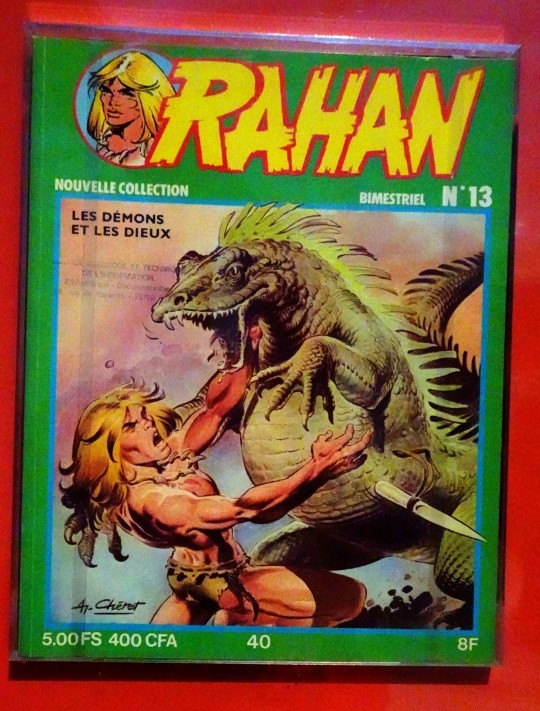
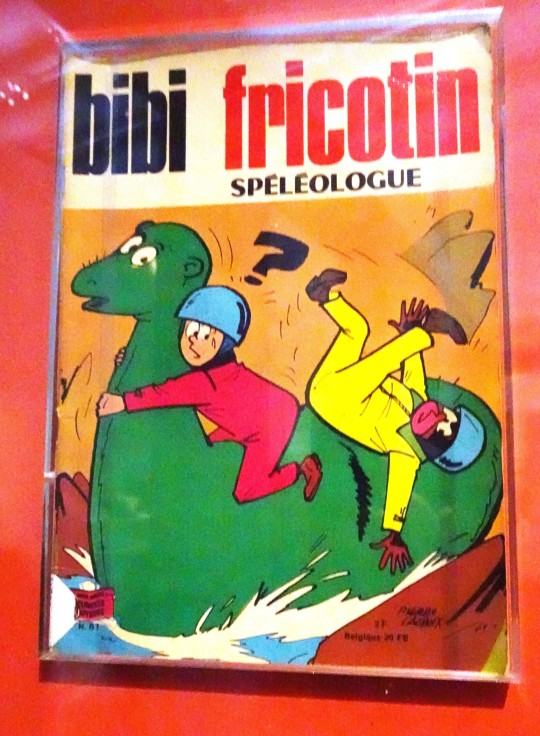

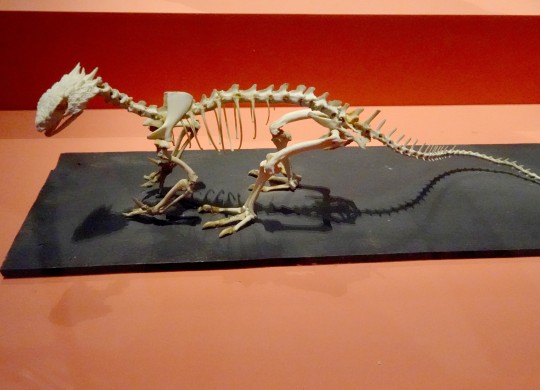
Il y a une petite quinzaine, je suis allé avec Julien et Katie, au Louvre-Lens pour une expo temporaire : "Animaux Fantastiques". Une très belle expo ! Ici des dragons et leurs cousins, les dinosaures !
John Martin, illustrateur pour le livre de Thomas Hawkins - "Le Livre des grands dragons de la mer, ichtyosaures et plésiosaures" -Londres,1840
Benjamin Waterhouse Hawkins - Iguanodon - Londres,1855 (on est bien loin de la représentation actuelle de ce dinosaure !!) - et...voir le dernier.
les 3 suivants : Rahan, Bibi Fricotin et autres magazines des années 70
Eric Pellé - "Multispecies incroyabilis" (E. Pellé est un préparateur en ostéologie du Muséum national d'Histoire Naturelle)
#expo#louvre-lens#animaux fantastiques#monstre#créature#dinosaure#john martin#thomas hawkins#angleterre#victorienne#iguanodon#ichtyosaure#plésiosaure#benjamin waterhouse hawkins#rahan#bibi fricotin#fantasy#eric pellé#chimère#hybride#multispecies mirabilis#ostéologie#muséum national d'histoire naturelle
4 notes
·
View notes
Photo
It is so weird to recently discovered dinosaurs done in Hawkins's style.

Atrociraptors (prints)
13K notes
·
View notes
Text

Megaloceros (Crystal Palace Dinosaurs) Benjamin Waterhouse Hawkins (1807–1894) Crystal Palace Park
45 notes
·
View notes
Text

Dinovember 2024 Day 5: Hadrosaurus foulkii
This species, which measured 7-8 meters long, weighed about 2-4 tons, and lived about 80.5-78.5 million years ago on a coastal floodplain in what is now the Woodbury Formation of New Jersey, was in 1858 the first dinosaur ever to be described in the United States and North America from good fossil remains. Ten years later the only known specimen of Hadrosaurus foulkii became the first skeleton of a dinosaur ever to be mounted and put on display at a public institution-the Philadelphia Academy of Natural Sciences-by the renowned English naturalist-sculptor Benjamin Waterhouse Hawkins, who is also famous for designing the sculptures of dinosaurs and other prehistoric animals on the grounds of London’s Crystal Palace.
Hadrosaurus lends its name to the Hadrosauridae, the large, battery-toothed, herd-dwelling and hoof-toed ornithopods that dominated Laurasia and even Patagonia throughout the Late Cretaceous, and it was also part of a fauna of unique hadrosaurids that lived on the eastern Island continent of Appalachia. These included the 3-meter-long Claosaurus from the Niobrara Formation of Kansas, the basal Eotrachodon and the 4.5-meter-long Lophorothon atopus from the Moorevile Chalk Formation of Alabama, and the truly gigantic 10 to 17-meter-long Hypsibelma.
#paleoart#dinosaur#dinosaurs#paleontology#dinovember 2024#draw dinovember#dinovember#hadrosaurus#hadrosaurs#hadrosaur
76 notes
·
View notes
Text
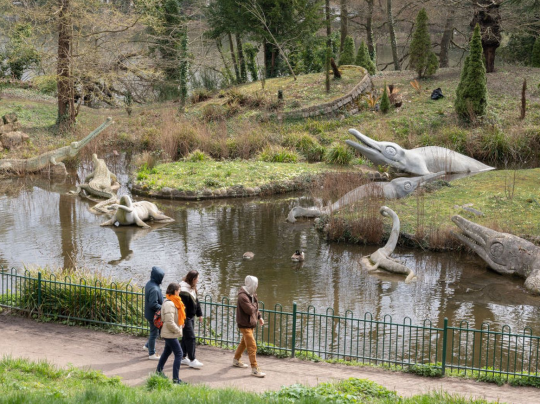
[ Visitors pass by some of the iconic sculptures of prehistoric life within Crystal Palace Park. Photo by Richard Baker. ]
"When the Crystal Palace and Park opened in south London in 1854, it was an instant sensation. Visitors came from far and wide to see the giant glass structure that had been rebuilt there, bigger and better, after the Great Exhibition of 1851 in Hyde Park. Wide-eyed spectators wandered freely through Egyptian and Medieval Courts, delighted in high-wire circus acts, and were transported by a 4,000-piece orchestra. Tucked away in a corner of the vast gardens that fanned out from the palace, past sweeping terraces and more fountains than even at Versailles, was a smaller but no less ambitious attraction. Scattered across several islands in the middle of a lake stood three dozen life-size sculptures of prehistoric animals, including several dinosaurs up to 30 feet long—the world’s first attempt to model them at full scale. The Crystal Palace Dinosaurs were the work of Benjamin Waterhouse Hawkins, a natural history artist who, aided by some of the leading scientists of the day, had dreamt up a grand experiment in visual education, bringing to life the “dry bones or oddly shaped stones” found in the British Museum and introducing the masses to the burgeoning science of paleontology. By reconstructing Britain’s long-extinct animals, he hoped to “render the appearance and names of the ancient inhabitants of our globe as familiar as household words.” The palace burned down in the 1930s, but, almost 170 years after they were crafted, most of Hawkins’ original sculptures still stand sentry in the park. Today, they’re mostly famous for being wildly inaccurate. With few complete fossils to work off, Hawkins had to use his imagination and the advice of comparative anatomists to breathe life into his models, which, in addition to four true dinosaurs, also depict prehistoric mammals, reptiles and amphibians. As a result, the sculptures look suspiciously like many modern-day creatures. “People kind of scoff and giggle, because they look so wrong today, but at the time they were really cutting-edge,” says Bob Nicholls, a paleoartist who, through careful study of archival images, recently reconstructed a lost sculpture that had disappeared from the park sometime in the 1960s. His tapir-like model of Palaeotherium magnum, an animal we now know looked a lot more like a horse, was unveiled in July and now stands among Hawkins’ own surviving creations."
Read more: "How a Victorian Dinosaur Park Became a Time Capsule of Early Paleontology" by Yannic Rack.
#palaeoblr#Crystal Palace#Crystal Palace Dinosaurs#Dinosaurs#Article#Information#London#England#Photo#Sculptures
271 notes
·
View notes
Photo
This is SOOOOO cool!

“The extinct animals” Model-room, at the Crystal Palace Sydenham / Artwork by Philip Henry Delamotte / The Illustrated London News / Dec. 31, 1858.
Benjamin Waterhouse Hawkin’s dinosaur workshop on the grounds of the Crystal Palace. At the time, dinosaurs were known only from a handful of teeth and bones, forcing Hawkins to improvise. The result was a grotesque variety of shapes reminiscent of reptiles, lizards, dragons, large mammals, birds, fish, kangaroos, and amphibians. // “Dinomania, the lost art of Winsor McCay, the secret origins of King Kong, and the urge to destroy New York”, Ulrich Merkl, Fantagraphics Books, Seattle 2015


#dinosaur#dinosaurs#benjamin waterhouse hawkin#philip henry delamotte#winsor mccay#tbr pile#Always a paleontology adventure
196 notes
·
View notes
Text

Benjamin Waterhouse Hawkin's conceptual drawing of the Paleozoic Museum, a proposed museum of natural history in Manhattan which was never completed, from The 13th Annual report of the Board of Commissioners of the Central Park for the Year Ending December 31st, 1869
https://archive.org/details/annualreportofbo00newy_2/page/n42/mode/1up
#benjamin waterhouse hawkins#1869#New York Central Park#Hadrosaurus#Laelaps#Elasmosaurus#Glyptodon#Megatherium#Mastodon
37 notes
·
View notes
Text
Crystal Palace Field Trip Part 1: Walking With Victorian Monsters
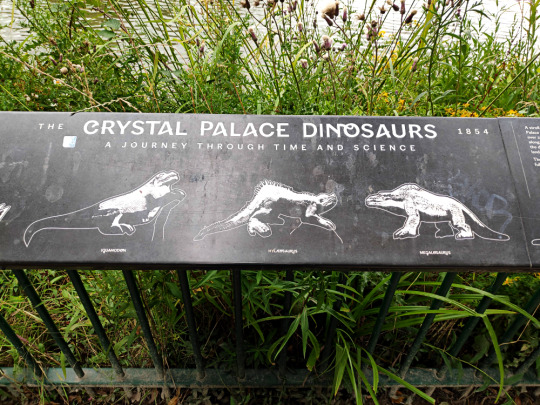
The Crystal Palace Dinosaurs take their name from the original Crystal Palace, a glass-paned exhibition building originally constructed for a World's Fair in Hyde Park in 1851.
In 1854 the structure was relocated 14km (~9 miles) south to the newly-created Crystal Palace Park, and a collection of over 30 life-sized statues of prehistoric animals were commissioned to accompany the reopening – creating a sort of Victorian dinosaur theme park – sculpted by Benjamin Waterhouse Hawkins with consultation from paleontologist Sir Richard Owen.
The Palace building itself burned down completely in 1936, and today only the ruins of its terraces remain in the northeast of the park grounds.

The Crystal Palace building then and now Left image circa 1854 (public domain) Right image circa 2011 by Mark Ahsmann (CC BY-SA 3.0)
Six sphinx statues based on the Great Sphinx of Tanis also survive up among the Palace ruins, flanking some of the terrace staircases. They fell into serious disrepair during the latter half of the 20th century, but in 2017 they all finally got some much-needed preservation work, repairing them and restoring their original Victorian red paint jobs.

———
…But let's get to what we're really here for. Dinosaurs! (…And assorted other prehistoric beasties!)
The "Dinosaur Court" down in the south end of the park still remains to this day, displayed across several islands in a man-made lake. Over the decades they've been through multiple cycles of neglect and renovation, and are currently cared for by the London Borough of Bromley (Crystal Palace Park Trust are due to take over custodial duties in September 2023), with promotion and fundraising assistance from organizations like Historic England and the Friends of the Crystal Palace Dinosaurs charity.
Just about 170 years old now, the Crystal Palace Dinosaurs represent fifteen different types of fossil creatures known to 1850s Victorian science, with only three actual dinosaur species featured. Although often derided for being outdated and very inaccurate by modern standards, they were actually incredibly good efforts at the time, especially taking into account that the field of paleontology was still in its very early days.
They also just have a lot of charm, with toothy grins and surprisingly dynamic poses.
Unfortunately on the day I visited in early August 2023 most of the statues were heavily obscured by plant growth, both on their islands and on the sides of the paths they can usually be viewed from. Since I'd seen images from about a month ago showing things being less overgrown, this was probably just some unlucky timing on my part coinciding with some explosive summer foliage growth.
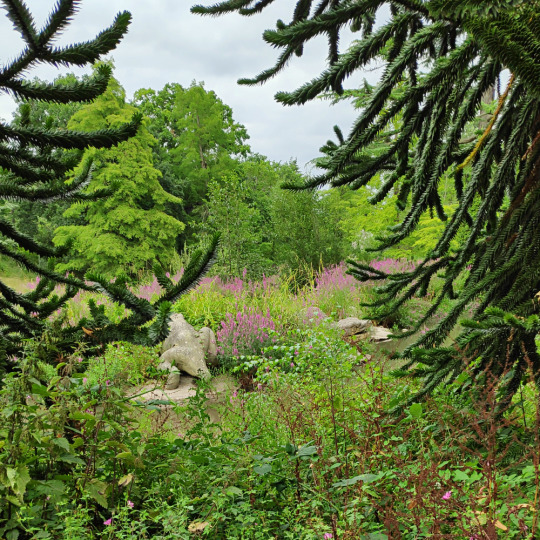
The first island on the trail features a few Permian and Triassic animals which were only known from fragmentary remains in the 1850s. These "labyrinthodonts" were recognized as having similarities to both amphibians and reptiles, and so were depicted with boxy toothy jaws, warty skin, stumpy tails, and long frog-like back legs.
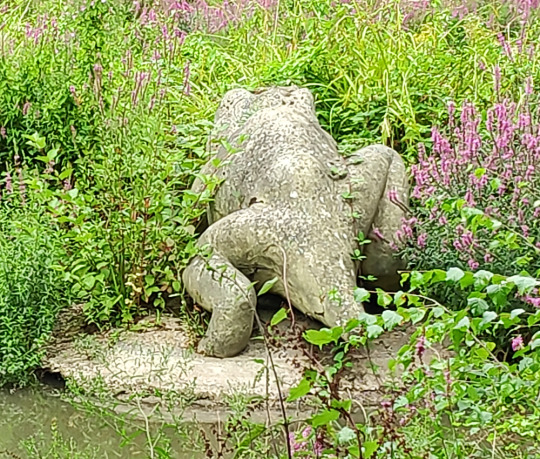
Today we'd call these particular animals temnospondyl amphibians, specifically Mastodonsaurus, and we know they were actually shaped more like giant salamanders with longer flatter crocodilian-like jaws, smaller legs, and long paddle-like tails.

———

Somewhere in the foliage beyond this specific "labyrinthodont" there was also supposed to be a pair of dicynodonts, but I couldn't see much of them at all and didn't manage to get a remotely visible photograph.
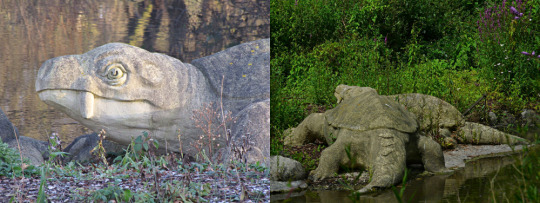
Crystal Palace Dicynodon when much less overgrown Left photo by London looks (CC BY 2.0) Right photo by Loz Pycock (CC BY SA 2.0)
These Dicynodon are depicted as looking like sabre-toothed turtles complete with shells. That was fairly speculative even for the time, but considering only their weird turtle-beaked-and-walrus-tusked skulls were known it was probably the best guess Hawkins and Owen had. Today we know these animals were actually synapsids related to modern mammals, but Victorian understanding considered them to be a type of reptile.
Modern reconstructions of dicynodonts have a slightly different face shape, along with squat pig-like bodies and semi-sprawling limbs. They may have had fur, but currently the only known actual skin impressions from the genus Lystrosaurus show leathery bumpy hairless skin.

———
Next time: the Jurassic and Cretaceous sculptures!
#field trip!#crystal palace dinosaurs#retrosaurs#i love them your honor#crystal palace park#crystal palace#labyrinthodont#temnospondyl#mastodonsaurus#dicynodont#dicynodon#synapsid#paleontology#vintage paleoart#art
387 notes
·
View notes
Text
I love when people argue in reblogable form for their favorites.
You are a delight as always, @allaboardthecolumboat
Time Travel Question 57: 19th Century
These Questions are the result of suggestions from the previous iteration.
This category may include suggestions made too late to fall into the correct grouping.
Please add new suggestions below if you have them for future consideration.
#pirate queen#pirates#piratical history#Time Travel#Tȟuŋkášila Šákpe#Indigenous history#US History#Paris Exhibition#Victorian#Fancy Dress Ball#The Statue of Liberty#Benjamin Waterhouse Hawkins#Iguanodon Dinner 1854#The Crash at Crush#Herman Melville#Nathaniel Hawthorne#Bram Stoker#Walt Whitman#Astor Place Riot#Pirate Queen Zheng Yi Sao#Ching Shih#Pirates#Chinese History#Beau Brummell#Frankenstein#The Vampyre#Mary Shelley#John William Polidori#Lord Byron#Percy Shelley
237 notes
·
View notes
Text

IT'S COMING HOME!
I have painstakingly reconstructed Benjamin Waterhouse Hawkins' Palaeotherium magnum sculpture. Lost decades ago, join us (Ellinor Michel, Mark Witton, Friends of Crystal Palace Dinosaurs) this Sunday to see its return.
More here: https://www.londonfestivalofarchitecture.org/event/beyond-the-dinosaurs-a-series-of-tours/
#Art#Painting#PaleoArt#PalaeoArt#SciArt#SciCom#DigitalArt#Illustration#Dinosaurs#Birds#Reptiles#Palaeontology#Paleontology#paleo#clay sculpting
288 notes
·
View notes
Text

Damn you Benjamin Waterhouse Hawkins for making Iguanodons too sexy! *shakes fist*
65 notes
·
View notes
Text
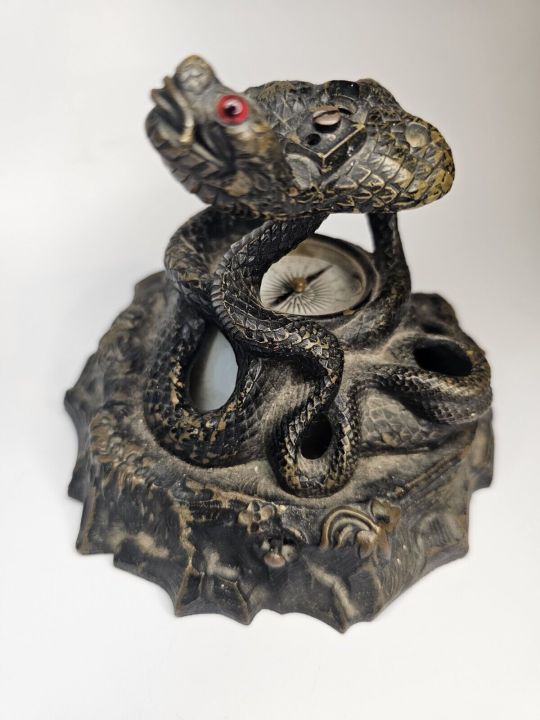
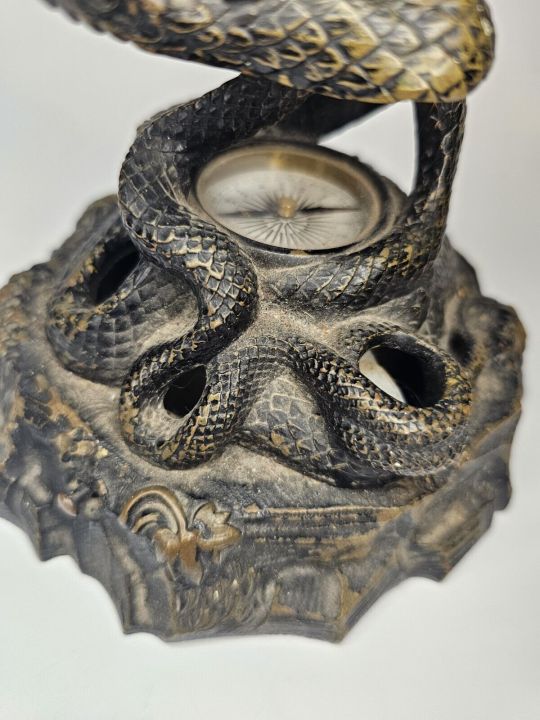

Rare Antique 1850 Benjamin Waterhouse Hawkins Bronze Heavy Snake CompassInkwell ebay The One Stop eShop
2 notes
·
View notes